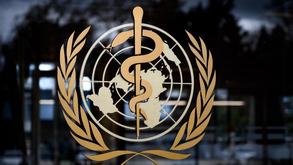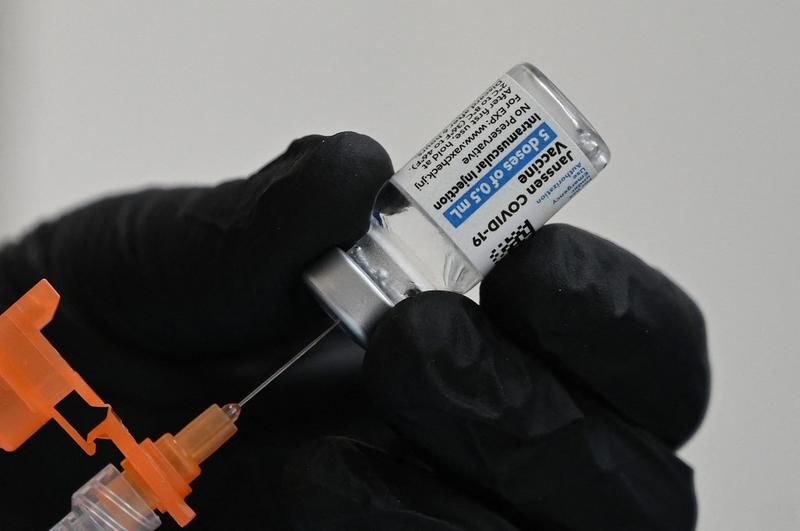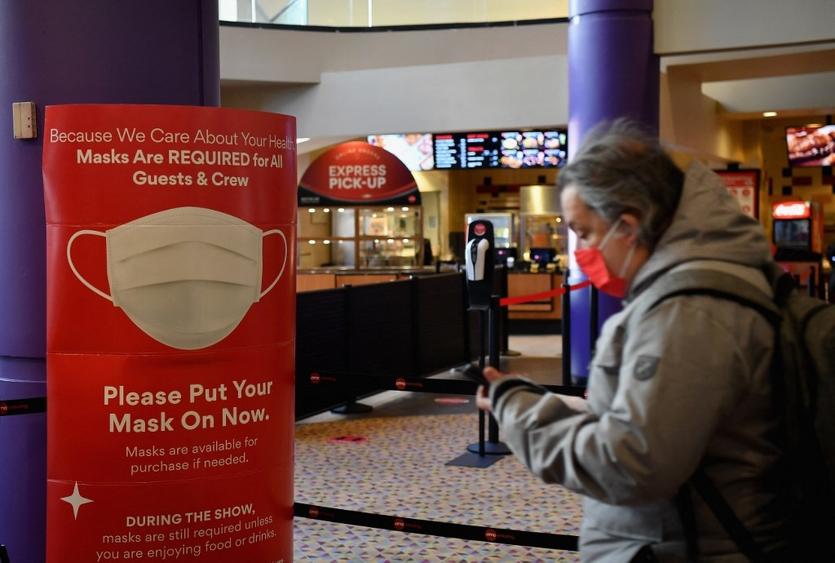 A file picture taken on March 9, 2020 shows the sign of the World Health Organization (WHO) at the WHO headquarters in Geneva. (FABRICE COFFRINI / AFP)
A file picture taken on March 9, 2020 shows the sign of the World Health Organization (WHO) at the WHO headquarters in Geneva. (FABRICE COFFRINI / AFP)
MILAN / LONDON / KINSHASA - A new wave of infections from the Omicron variant of the coronavirus is moving towards the east of Europe, the World Health Organization said on Tuesday, urging authorities to improve vaccination and other measures.
Over the past two weeks, cases of COVID-19 have more than doubled in Armenia, Azerbaijan, Belarus, Georgia, Russia and Ukraine, WHO's Europe regional director Hans Kluge said in a statement
Over the past two weeks, cases of COVID-19 have more than doubled in Armenia, Azerbaijan, Belarus, Georgia, Russia and Ukraine, WHO's Europe regional director Hans Kluge said in a statement.
The comments come at a time when several European countries including the Czech Republic and Poland have hinted at easing of COVID-19 restrictions next month if daily infection numbers kept falling.
The WHO, however, stressed the continued need for measures such as rapid testing and masking, saying over 165 million COVID-19 cases have been recorded so far across the WHO European region, with 25,000 deaths in the past week.
"Faced with the Omicron tidal wave, and with Delta still circulating widely in the east, this worrying situation is not the moment to lift measures that we know work in reducing the spread of COVID-19," Kluge said.
He also called on governments to examine local reasons for low vaccination rates. Less than 40 percent of those aged over 60 in Bosnia and Herzegovina, Bulgaria, Kyrgyzstan, Ukraine and Uzbekistan have completed their COVID-19 vaccine series, he said.
 A demonstrator rides a horse during a protest by truck drivers over Covid-19 pandemic health rules and the Trudeau government, outside the parliament of Canada in Ottawa, Ontario, on Feb 13, 2022. (ED JONES / AFP)
A demonstrator rides a horse during a protest by truck drivers over Covid-19 pandemic health rules and the Trudeau government, outside the parliament of Canada in Ottawa, Ontario, on Feb 13, 2022. (ED JONES / AFP)
Canada
The Canadian province of Ontario said it will speed up its plan to remove proof-of-vaccination requirements and lift pandemic-related capacity limits for many businesses while the western province of Alberta ended its mask requirements for school children on Monday.
The moves, which the provinces' premiers attributed to a waning Omicron wave, comes as protesters opposed to pandemic measures closed three border crossings with the United States and paralyzed parts of Ottawa for three weeks. read more
Ontario, Canada's most populous province, said coronavirus infections peaked last month and new hospitalizations have been declining week over week, signaling that the worst of the Omicron variant-driven COVID-19 wave was over.
The province had eased some capacity limits on Jan 31 and had previously planned to remove COVID-19-related curbs in gradual phases on Feb 21 and March 14. read more
It will now lift the so-called vaccine passports system on March 1 and remove capacity limits, including on restaurants and bars, on Thursday. Businesses may still choose to continue to require such proof, the province said, and masks will continue to be required.
 In this file photo taken on Aug 19, 2021, a nurse fills a syringe with Johnson & Johnson's Janssen Covid-19 vaccine at a clinic. (ROBYN BECK / AFP)
In this file photo taken on Aug 19, 2021, a nurse fills a syringe with Johnson & Johnson's Janssen Covid-19 vaccine at a clinic. (ROBYN BECK / AFP)
COVID-19 Study
The immune response to COVID-19 helps protect against reinfection, but that protection is weaker against Omicron than it was against earlier variants of the coronavirus, according to new data.
A previous SARS-CoV-2 infection protects against Omicron reinfection only 56 percent of the time, researchers found in a review of national data in Qatar. Having had COVID-19 was 90.2 percent effective against reinfection with the Alpha variant, 85.7 percent effective against a Beta variant reinfection, and 92 percent effective against Delta reinfection, researchers reported on Wednesday in The New England Journal of Medicine.
As was the case with reinfection due to earlier variants, however, "the protection of previous infection against hospitalization or death caused by reinfection (with Omicron) appeared to be robust," they said. In cases of reinfection with Omicron, for example, the immune response to previous infection was 87.8 percent effective at preventing the second infection from progressing to severe or critical illness or death.
DR Congo
The Democratic Republic of the Congo announced late Monday its decision to ease COVID-19 restrictions, including lifting curfews throughout the country except in Ituri and North Kivu provinces which are under a state of siege.
According to the latest assessment by the DRC's health authorities, the pandemic situation across the country has improved, especially in its capital Kinshasa, which was previously considered as the epicenter of the pandemic in the country.
However, health authorities fear the possible occurrence of a fifth wave between April and July, citing the low vaccination rate among the population.
The DRC has reported to date 85,839 confirmed cases, including 1,335 deaths.
 A protester holding the Italian flag sits in before anti-riot policemen (Rear) during a demonstration against the so-called "Super Green Pass", imposing new restrictions in the face of a sharp rise in COVID-19 infections in Italy on Jan 15, 2022 near piazza San Giovanni in Rome. (FILIPPO MONTEFORTE / AFP)
A protester holding the Italian flag sits in before anti-riot policemen (Rear) during a demonstration against the so-called "Super Green Pass", imposing new restrictions in the face of a sharp rise in COVID-19 infections in Italy on Jan 15, 2022 near piazza San Giovanni in Rome. (FILIPPO MONTEFORTE / AFP)
Italy
Italy reported 28,630 COVID-19 related cases on Monday, against 51,959 the day before, the health ministry said, while the number of deaths rose to 281 from 191.
Italy has registered 151,296 deaths linked to COVID-19 since its outbreak emerged in February 2020, the second-highest toll in Europe after Britain and the eighth highest in the world. The country has reported 12.1 million cases to date.
Patients in hospital with COVID-19 - not including those in intensive care - stood at 16,050 on Monday, down from 16,060 a day earlier.
 In this July 27, 2020 photo, a nurse prepares a shot as a study of a possible COVID-19 vaccine, developed by the National Institutes of Health and Moderna. (PHOTO / AP)
In this July 27, 2020 photo, a nurse prepares a shot as a study of a possible COVID-19 vaccine, developed by the National Institutes of Health and Moderna. (PHOTO / AP)
mRNA vaccines
Protection provided by booster shots of the mRNA vaccines from Moderna Inc or Pfizer Inc and partner BioNTech SE starts waning quickly, according to data published in Friday's Morbidity and Mortality Weekly Report from the US Centers for Disease Control and Prevention.
Researchers reported that within two months after the second dose of an mRNA vaccine during the surge in infections caused by the Delta variant of the virus, vaccine efficacy was 94 percent against hospitalization and 92 percent against emergency department or urgent care visits. Efficacy waned thereafter, but climbed to 96 percent and 97 percent, respectively, at two months after a booster shot.
Four months later, however, that protection had declined to 76 percent and 89 percent.
Once Omicron became predominant, vaccine efficacy was 71 percent against hospitalization and 69 percent against ED/UC visits within two months after the second dose, 91 percent and 87 percent at two months after a booster, and 78 percent and 66 percent four months later.
The estimates are drawn from analyses of 241,204 COVID-related ED/UC visits and 93,408 hospitalizations between August and January.
 This file photo taken on Nov 17, 2020 shows vials with COVID-19 Vaccine stickers attached and syringes with the logo of US biotech company Novavax. (JUSTIN TALLIS / AFP)
This file photo taken on Nov 17, 2020 shows vials with COVID-19 Vaccine stickers attached and syringes with the logo of US biotech company Novavax. (JUSTIN TALLIS / AFP)
Novavax
Novavax Inc has submitted an application to Switzerland's drugs regulator for the authorization of its COVID-19 vaccine in adults, the US vaccine maker said on Monday.
The submission is based on data from two key clinical trials in the United States and Mexico as well as in the UK that showed the vaccine was 90 percent effective against COVID-19.
Novavax's protein-based vaccine is being reviewed by the US Food and Drug Administration and has received approvals from the European Union and the World Health Organization.
It has also been cleared for use in adults in countries including the UK, New Zealand and Australia. The company last week said its vaccine was about 80 percent effective in a late-stage trial in adolescents.
UK
Britain on Monday reported 41,648 new cases of COVID-19 and 35 deaths further deaths within 28 days of a positive test, government statistics showed.
Cases over the last seven days are down 30 percent on the previous week, with weekly deaths down 27.2 percent compared to the previous seven days.
 In this file photo taken on March 05, 2021, a mask requirement post welcomes patrons at AMC Empire 25 off Times Square in New York City. (ANGELA WEISS / AFP)
In this file photo taken on March 05, 2021, a mask requirement post welcomes patrons at AMC Empire 25 off Times Square in New York City. (ANGELA WEISS / AFP)
US
Washington DC will no longer require people show proof of COVID-19 vaccination to enter many businesses beginning on Tuesday, its mayor said, joining a slew of local leaders who are dialing back pandemic restrictions as the Omicron wave ebbs.
Mayor Muriel Bowser also announced on Monday that the city will no longer make masks mandatory in many indoor settings - including restaurants, bars, gyms and houses of worship - starting on March 1.
Masks will still be required in schools, libraries, nursing homes, public transit and healthcare facilities, among other settings.
Bowser said a dramatic drop in COVID-19 cases and hospitalizations in recent weeks spurred the decision to relax some of the emergency measures introduced in December.
In neighboring Maryland, Governor Larry Hogan, a Republican, announced on Monday that the requirement for masks and face coverings in state buildings will end on Feb 22.
Hogan has also called on the state's board of education to rescind its school mask policy.
The governors of New York and Massachusetts announced last week that they would end certain mask mandates in their states, following similar moves by New Jersey, California, Connecticut, Delaware and Oregon.


